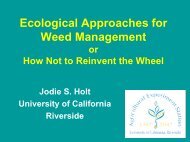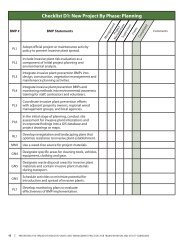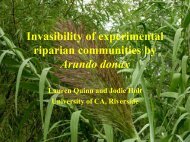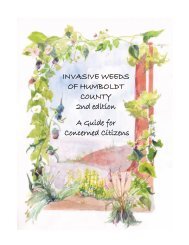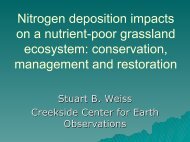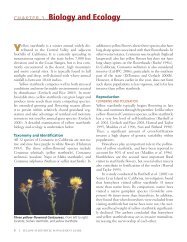Fire on the Mountain*: a Land Manager's Manifesto for ... - Cal-IPC
Fire on the Mountain*: a Land Manager's Manifesto for ... - Cal-IPC
Fire on the Mountain*: a Land Manager's Manifesto for ... - Cal-IPC
Create successful ePaper yourself
Turn your PDF publications into a flip-book with our unique Google optimized e-Paper software.
<strong>Cal</strong>i<strong>for</strong>nia Exotic Pest Plant Council1997 Symposium Proceedingsexhausted by germinati<strong>on</strong> and mortality. Nei<strong>the</strong>r will occur at appreciable rates without procedures to enhance<strong>the</strong>m - dormancy of most seed can <strong>on</strong>ly be broken by heat, and dormant seed is l<strong>on</strong>g-lived based <strong>on</strong> in<strong>for</strong>mati<strong>on</strong>about closely related species. Scotch broom seeds remain viable <strong>for</strong> at least 80 years (Turner 1933), and manyo<strong>the</strong>r legume seeds are known to have much greater l<strong>on</strong>gevity (Baker 1989). Since <strong>the</strong>re is no o<strong>the</strong>r practicablemeans of treating seed to reduce <strong>the</strong> seed bank, c<strong>on</strong>trol of broom will require fire <strong>on</strong> <strong>the</strong> Mountain.Odi<strong>on</strong> and Haubensak (in press), studied resp<strong>on</strong>se of French broom seed banks to burning. In mixedannual/native grassland <strong>on</strong> <strong>the</strong> watershed, 1-2 in tall, 5-10 year old broom stands had 500-4300 seeds/m 2 .Burning cut stands with <strong>the</strong> additi<strong>on</strong> of slash fuel significantly increased germinati<strong>on</strong>, and following a sec<strong>on</strong>dburn 1 year later, emergence was reduced to low levels. In c<strong>on</strong>trast, 2-3 in tall, 15-25 year old stands had4,300-14,000 seeds/m 2 , with a sizable porti<strong>on</strong> too deeply buried to be killed or induced to germinate using firetreatments.Grassland soils invaded by broom also had significantly more available nitrogen than soils in uninvadedplots. After burning, broom invaded areas remained enriched. Soil nitrogen enrichment is a c<strong>on</strong>cern because ithas been documented in many cases, going back to <strong>the</strong> work of Lawes and Gilbert in 1880 (see Vitousek et al.1997), that this may shift dominance to nitrogen demanding plants. Thus, French broom may alter sites to bemore favorable to fast growing, weedy plants, and it is uncertain how to ameliorate this.Broom C<strong>on</strong>trol StrategyThe most important c<strong>on</strong>clusi<strong>on</strong> from this research is that as broom stands age (Fig. 1), seed accumulati<strong>on</strong> atgreater soil depths will cause a transiti<strong>on</strong> from an infestati<strong>on</strong> that may be possible to c<strong>on</strong>trol with fuel additi<strong>on</strong>,repeat burning and follow up treatments, to <strong>on</strong>e that will require chr<strong>on</strong>ic treatment indefinitely to eliminateemerging plants. Un<strong>for</strong>tunately, most broom infestati<strong>on</strong>s <strong>on</strong> <strong>the</strong> watershed have already underg<strong>on</strong>e thistransiti<strong>on</strong>. There<strong>for</strong>e, we developed a two-pr<strong>on</strong>ged management strategy, <strong>on</strong>e <strong>for</strong> dealing with a resilient landailment and ano<strong>the</strong>r <strong>for</strong> preventing infestati<strong>on</strong>s from becoming a resilient ailment.Fig. 1. Changes in French broom seed bank with time.<str<strong>on</strong>g>Fire</str<strong>on</strong>g> is needed to c<strong>on</strong>trol both young and old stands because it depletes <strong>the</strong> seed bank. It also c<strong>on</strong>trolsresprouting if repeated every 1-4 years, so that regenerating broom does not reach reproductive age. <str<strong>on</strong>g>Fire</str<strong>on</strong>g> costsrelatively little, provides additi<strong>on</strong>al ecological benefits, and does not raise toxicological c<strong>on</strong>cerns. MMWD hasnot c<strong>on</strong>sidered methods of pois<strong>on</strong>ing seed, or <strong>the</strong> soil that seedlings emerge through, because <strong>the</strong>se have broadspectrum biocidal impacts that are unacceptable <strong>on</strong> Watershed lands. The same would apply in most wildlandsettings. O<strong>the</strong>r methods of eliminating existing broom stands (Table 2) have little effect <strong>on</strong> <strong>the</strong> seed bank.Herbicides are listed am<strong>on</strong>g broom killing tools in Table 2 because <strong>the</strong>y will be an opti<strong>on</strong> <strong>for</strong> many landmanagers. MMWD policy prohibits using <strong>the</strong>se chemicals <strong>on</strong> lands draining into reservoirs, and, due to publicsentiment, avoids any broadcast applicati<strong>on</strong> <strong>on</strong> o<strong>the</strong>r lands it manages.With prescribed fire, <strong>the</strong>re is <strong>the</strong> risk of escape and of causing unintended mortality of n<strong>on</strong>-sproutingc<strong>on</strong>ifers (Swezy and Agee 1991). There are also negative effects from repeat and out-of seas<strong>on</strong> burning inPage 2





